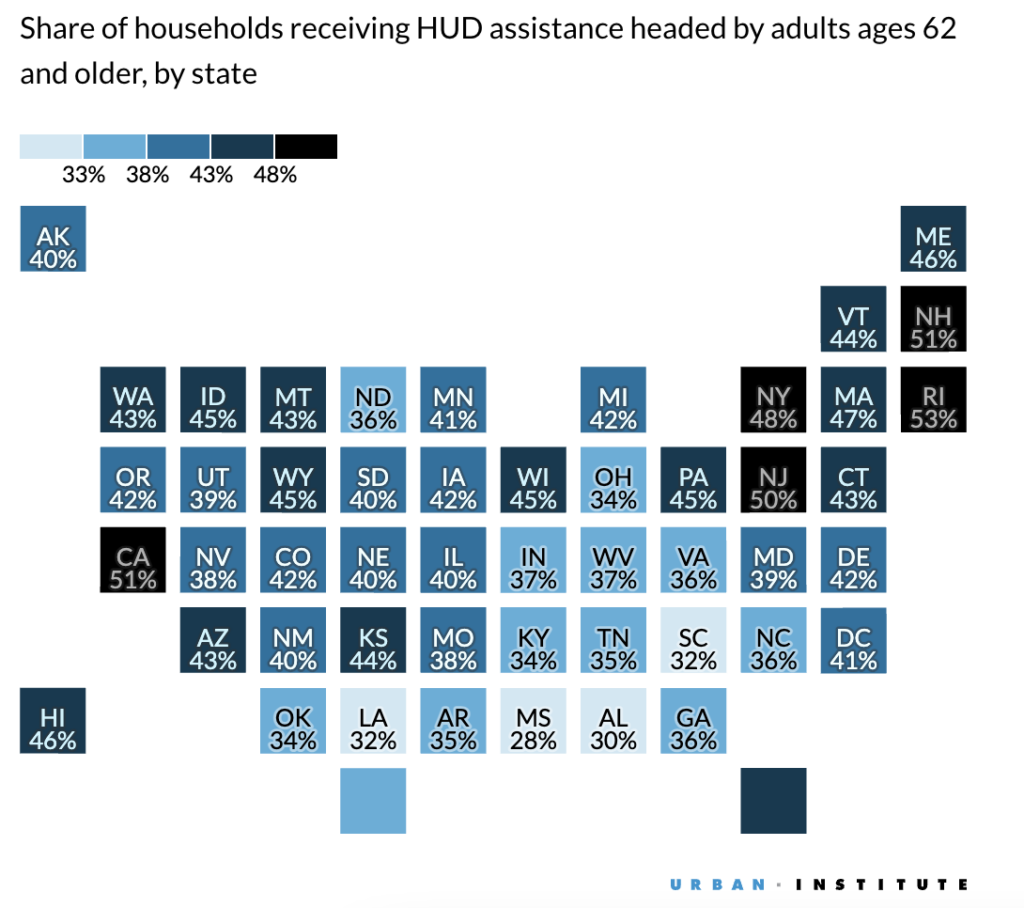Older Americans now make up a growing portion of the U.S. population as the baby boomer generation approaches retirement age. About one in six persons—55.8 million people—were 65 or older in 2020, according to the U.S. Census. A new report from the Urban Institute reveals just how significant and in what ways the U.S. Department of Housing and Urban Development (HUD) cuts will affect older generations.
However, the housing market has found it difficult to accommodate the demands of seniors, particularly those with low incomes, as the U.S. population has gotten older. Furthermore, only a small percentage of elderly people in need of housing help are able to get it.
Rental assistance is available for little under 6 million elderly families with very low incomes (PDF), according to recent estimates. However, HUD only provided housing aid to roughly 1.9 million senior households in 2024. The percentage of senior households in HUD-assisted housing has increased from 33% in 2014 to 42% now.
At a time when need is increasing, older folks will probably be disproportionately impacted by the Trump administration’s plans to cut HUD staffing in half, shut agency field offices, and cut financing for HUD programs. Effective housing program administration will probably be hampered by the cuts, however it is unclear how they will impact particular housing aid programs at this time.
In the end, these reductions may erode services that support individuals in aging in place, increasing the likelihood of institutionalization, homelessness, disease, and death for older folks. Local and state legislators will probably need to have a bigger role in delivering services if they want to guarantee that older and handicapped persons have access to enough affordable housing that meets their needs.
Share of Older Households Receiving HUD Assistance Jumped in the Last Decade
In an effort to better serve senior citizens, HUD has recently encouraged innovations in its main housing assistance programs. Public housing organizations (PHAs) have been able to implement policy improvements and get financing flexibility under HUD’s Moving to Work program. These funds have been utilized by numerous PHAs to carry out initiatives aimed at senior households.
The financial stability and living conditions of residents have been enhanced by other PHAs taking part in HUD’s Rental Assistance Demonstration (RAD). Through RAD, agencies can transform public housing assets into project-based voucher properties with different ownership and management arrangements. PHAs taking part in RAD have sponsored the provision of services for senior citizens and renovated houses.
In four states (Rhode Island, California, New Hampshire, and New Jersey), at least half of all HUD-advantaged households are senior households. They account for between 40 and 50% of those receiving HUD assistance in 27 states.

But securing a housing unit isn’t the only thing that requires support. In HUD-assisted housing, a household member with a handicap is present in approximately half of senior households (48 percent). These homes receive assistance from HUD through its Service Coordinator Program, which supports those with disabilities and the elderly.
More physicians or property managers might discover patients being released from the hospital without food or care if HUD funding for support services and coordination is not available. This would put further demand on an emergency response system that is already overworked and expensive. People with disabilities and older persons are more likely to be institutionalized and experience worse health outcomes if they are unable to obtain the resources they require in their communities.
Older Generations More Likely to Receive HUD Assistance
Numerous households with older persons are served by several HUD programs, such as the following:
- Housing choice vouchers, which provide about 800,000 senior households a subsidy to rent a home in the private market
- Project-based vouchers, which provide rental assistance for a specific building or unit to about 650,000 senior households
- Public housing, which offers affordable rental housing to about 650,000 senior households
- The Section 202 Supportive Housing for the Elderly Program, which offers housing to about 120,000 households, representing 6.3% of senior households who receive HUD assistance
HUD Cuts to Unfairly Impact Older Americans w/ Low Incomes
The suggested budget and employee cuts at HUD occur within a larger, already-stressed service provider ecosystem. Cuts have also been made to other government programs that assist low-income seniors, including those run by the US Department of Health and Human Services’ Administration for Community Living (ACL). The majority of employees have been let go, and HHS officials say they plan to stop providing some state funding. Through initiatives like Meals on Wheels, the ACL provides meals to the elderly and disabled and sponsors senior facilities. These services are at risk due to staff turnover.
Seniors and those with disabilities had a difficult time getting the housing and resources they required to succeed, even before the present unpredictability at federal agencies.
In order to guarantee that older and disabled persons have access to enough cheap and accessible homes to suit their needs, local and state legislators will probably need to be more innovative and expand their involvement in delivering services as a result of the impending HUD cuts.
To read more, click here.






